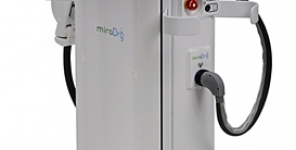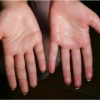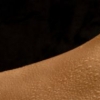Confronto tra iniezione intradermica e ionoforesi delle tossina abobotulinum A per il trattamento dell'iperidrosi ascellare primaria: uno studio randomizzato e controllato
 L'iniezione con neurotossina botulinica di tipo A (BTX-A) è il trattamento scelto per l'Iperidrosi Ascellare Idiopatica (IAH) refrattaria ai trattamenti convenzionali.
L'iniezione con neurotossina botulinica di tipo A (BTX-A) è il trattamento scelto per l'Iperidrosi Ascellare Idiopatica (IAH) refrattaria ai trattamenti convenzionali.
Obiettivo: Questo studio ha messo a confronto l'efficacia dell'iniezione e della ionoforesi con BTX-A per il trattamento di IAH in uno studio controllato e randomizzato.
Metodi: In undici pazienti con diagnosi di IAH, è stata trattata in modo casuale una sola ascella con iniezioni di 1.5 mL (250 MU) di BTX-A, mentre l'altro lato è stato trattato con BTX-A somministrata per ionoforesi. Per ciascuna ascella è stata confrontata la quantità di sudorazione, l'idratazione della pelle, la perdita trans-epidermica di acqua, il dolore, e la soddisfazione del paziente a livello basale, ma è stato fatto anche un confronto tra le due parti dopo 1 settimana, 1 mese e 6 mesi dal trattamento.
Risultati: Il lato di iniezione ha avuto una produzione si sudore significativamente inferiore rispetto al lato trattato con ionoforesi alla settimana 1, al mese 1, e a 6 mesi dopo il trattamento (84%, 76% e 50% vs. 73%, 22%, e 32%, rispettivamente). Tuttavia, la risposta alla ionoforesi è stata molto più stabile rispetto alla risposta all'iniezione. La percezione del dolore da parte dei partecipanti, nel corso della procedura, è stata significativamente minore sul lato con ionoforesi rispetto al lato di iniezione (15.0 vs. 20.0, p <0.05).
Conclusione: Questo studio ha mostrato che l'iniezione è un metodo più efficace per la somministrazione di BTX-A, ma la ionoforesi può essere considerata come un metodo non invasivo e indolore utile in alcuni pazienti.
Storia della pubblicazione:
Titolo: Comparison of intradermal injection with iontophoresis of abobotulinum toxin A for the treatment of primary axillary hyperhidrosis: A randomized, controlled trial.
Rivista: J Dermatolog Treat. 2012 Oct 30.
Autori: Montaser-Kouhsari L, Zartab H, Fanian F, Noorian N, Sadr B, Nassiri-Kashani M, Firooz A.
Affiliazioni: Center for Research and Training in Skin Diseases and Leprosy, Tehran University of Medical Sciences, Tehran, Iran, Islamic Republic of.
Abstract:
Abstract Background: Botulinum neurotoxin type A (BTX-A) injection is the treatment of choice for Idiopathic axillary hyperhidrosis (IAH) refractory to conventional treatments. Objective: This study compares the efficacy of BTX-A injection and iontophoresis for treatment of IAH in a randomized controlled trial. Methods: In eleven patients with the diagnosis of IAH, one axilla was randomly treated with injections of 1.5 mL (250 MU) of BTX-A, and the other side was treated with BTX-A administered by iontophoresis. The amount of sweating, skin hydration, transepidermal water loss, pain, and patient satisfaction on both axilla were compared with baseline levels, and also between both sides 1 week, 1 month and 6 months after treatment. Results: The injection side had significantly less sweat production than the iontophoresis side 1 week, 1 month, and 6 months after treatment (84%, 76%, and 50% vs 73%, 22%, and 32%, respectively). However, the response to iontophoresis was more stable than the response to injection. Participants' pain perception during the procedure score was significantly less on the iontophoresis side compared to injection side (15.0 vs. 20.0, p < 0.05). Conclusion: This study showed that injection is a more effective method for the administration of BTX-A, though iontophoresis can also be considered as a non-invasive and painless method helpful in some patients.





